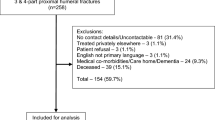Abstract
We describe a new classification of complex 4-part proximal humeral fractures (PHF). Its novelty lies in the involvement of fractures of the calcar area (i.e., the missing fifth fragment) in relation to fragments of the head, tuberosities and shaft. The classification consists of 6 groups (divided into 15 subgroups) of calcar fracture patterns. We hypothesized that this classification could aid surgical decision making in terms of osteosynthesis versus prothesis. To test this hypothesis, two shoulder surgeons, trained in the classification, re-examined the X-rays and CT scans of 100 cases of 4-part PHF to codify each calcar fracture pattern. CT scans proved to be essential for this process. We then theoretically assigned the most appropriate treatment to each subgroup. Subsequent verification of clinical records confirmed our hypothesis that this classification could help the surgeon to decide the best approach to complex 4-part PHF.




Similar content being viewed by others
References
Murray IR, Amin AK, White TO, Robinson CM (2011) Proximal humeral fractures: current concepts in classification, treatment and outcomes. J Bone Joint Surg Br 93(1):1–11
Codman EA (1934) Fractures in relation to the subacromial bursa. In: Codman EA (ed) The shoulder: rupture of the supraspinatus tendon and other lesions in or about the subacromial bursa. Thomas Todd, Boston, MA, pp 313–333
Neer CS 2nd (1970) Displaced proximal humeral fractures: I. classification and evaluation. J Bone Joint Surg Am 52:1077–1089
Neer CS 2nd (2002) Four-segment classification of proximal humeral fractures: purpose and reliable use. J Shoulder Elbow Surg 11:389–400
Müller ME, Nazarian S, Koch P, Schatzker J (1990) The comprehensive classification of fractures in long bones. Springer-Verlag, Berlin, Germany
Hertel R (2005) Fractures of the proximal humerus in osteoporotic bone. Osteoporos Int 16(Suppl 2):S65–S72
Hertel R, Hempfing A, Stiehler M, Leunig M (2004) Predictors of humeral head ischemia after intracapsular fracture of the proximal humerus. J Shoulder Elbow Surg 13:427–433
Majed A, Macleod I, Bull AM, Zyto K, Resch H, Hertel R, Reilly P, Emery RJ (2011) Proximal humeral fracture classification systems revisited. J Shoulder Elbow Surg 20(7):1125–1132
Tamai K, Ishige N, Kuroda S, Ohno W, Itoh H, Hashiguchi H, Iizawa N, Mikasa M (2009) Four-segment classification of proximal humeral fractures revisited: a multicenter study on 509 cases. J Shoulder Elbow Surg 18:845–850
Mauro CS (2011) Proximal humeral fractures. Curr Rev Musculoskelet Med 4(4):214–220
Mora Guix JM, Pedrós JS, Serrano AC (2009) Updated classification system for proximal humeral fractures. Clin Med Res 7(1–2):32–44
Robinson BC, Athwal GS, Sanchez-Sotelo J, Rispoli DM (2008) Classification and imaging of proximal humerus fractures. Orthop Clin North Am 39(4):393–403
Russo R, Visconti V, Lombardi LV, Ciccarelli M, Giudice G (2008) The block-bridge system: a new concept and surgical technique to reconstruct articular surfaces and tuberosities in complex proximal humeral fractures. J Shoulder Elbow Surg 17(1):29–36
Russo R, Visconti V, Lombardi LV, Ciccarelli M, Cautiero F (2010) Da Vinci system: clinical experience with complex proximal humerus fractures. Musculoskelet Surg 94(Suppl 1):S57–S64
Charalambous CP, Siddique I, Valluripalli K, Kovacevic M, Panose P, Srinivasan M, Marynissen H (2007) Proximal humeral internal locking system (PHILOS) for the treatment of proximal humeral fractures. Arch Orthop Trauma Surg 127(3):205–210
Gardner MJ, Weil Y, Barker JU, Kelly BT, Helfet DL, Lorich DG (2007) The importance of medial support in locked plating of proximal humerus fractures. J Orthop Trauma 21(3):185–191
Egol KA, Ong CC, Walsh M, Jazrawi LM, Tejwani NC, Zuckerman JD (2008) Early complications in proximal humerus fractures (OTA types 11) treated with locked plates. J Orthop Trauma 22(3):159–164
Lee CW, Shin SJ (2009) Prognostic factors for unstable proximal humeral fractures treated with locking-plate fixation. J Shoulder Elbow Surg 18(1):83–88
Fankhauser F, Boldin C, Schippinger G, Haunschmid C, Szyszkowitz R (2005) A new locking plate for unstable fractures of the proximal humerus. Clin Orthop Relat Res 430:176–181
Brunner F, Sommer C, Bahrs C, Heuwinkel R, Hafner C, Rillmann P, Kohut G, Ekelund A, Muller M, Audigé L, Babst R (2009) Open reduction and internal fixation of proximal humerus fractures using a proximal humeral locked plate: a prospective multicenter analysis. J Orthop Trauma 23(3):163–172
Mora Guix JM, Gonzalez AS, Brugalla JV, Carril EC, Baños FG (2006) Proposed protocol for reading images of humeral head fractures. Clin Orthop Relat 448:225–233
Russo R, Vernaglia Lombardi L, Cautiero F, Giudice G, Ciccarelli M (2008) Medial reconstruction technique in the treatment of complex fractures of humeral proximal epiphysis with SMR prosthetic modular system. Chir Organi Mov 91(2):117–123
Greiner S, Kääb MJ, Haas NP, Bail HJ (2009) Humeral head necrosis rate at mid-term follow-up after open reduction and angular stable plate fixation for proximal humeral fractures. Injury 40(2):186–191
Acknowledgments
We are grateful to Jean Ann Gilder (Scientific Communication srl) for editing the text.
Conflict of interest
None.
Author information
Authors and Affiliations
Corresponding author
Rights and permissions
About this article
Cite this article
Russo, R., Cautiero, F. & Della Rotonda, G. The classification of complex 4-part humeral fractures revisited: the missing fifth fragment and indications for surgery. Musculoskelet Surg 96 (Suppl 1), 13–19 (2012). https://doi.org/10.1007/s12306-012-0195-2
Received:
Accepted:
Published:
Issue Date:
DOI: https://doi.org/10.1007/s12306-012-0195-2




